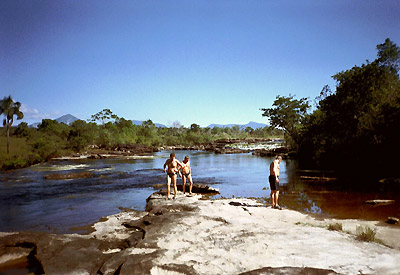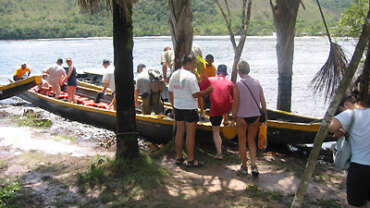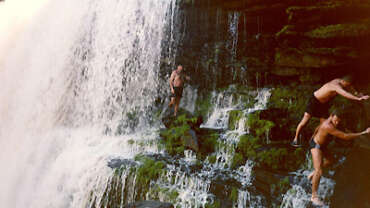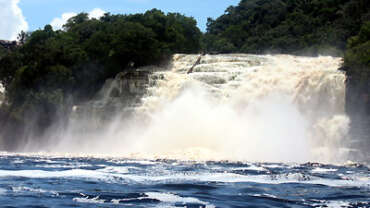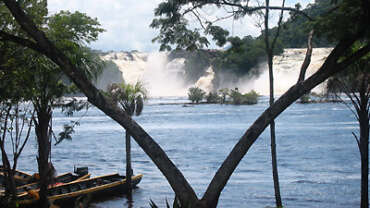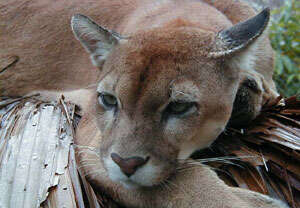The Andes
The Andes are one of the world’s great mountain ranges and the backbone of South America. The Venezuelan Andes, 400km long and 50-100km wide, begin in Barquisimeto and run through the states of Trujillo, Mérida and Táchira before reaching the Colombian border. The jagged rocky peaks, shimmering glacial lakes, bleak highlands and snow-capped summits create a stunning landscape which is typically Andean. The mountains divide into two major chains running parallel to one another: la Sierra Nevada de Mérida, and la Sierra de la Culata, both of which have been declared national parks.
Besides being a heaven for botanists and wildlife enthusiasts, the Andes is by far the best place in the country to practice adventure sports. A host of activities are on offer, such as hiking, trekking, mountaineering, climbing, paragliding, fishing, horseriding, camping and mountain biking, all if which can be arranged through various tour agencies.
Merida
Occupying the valley between the southern and northern sierras is the city of Mérida, the capital of Mérida State. At an altitude of 1,640m, it is the highest state capital of the country. Mérida was founded in 1558 by an explorer sent from present-day Columbia (then Nueva Granada), and remained under Colombian rule until 1777. It was this city that christened Simon Bolívar El Libertador, and erected the first monument in his honor. Today, Mérida is Venezuela’s most popular destination for backpackers and tourists, and has plenty of hotels and restaurants. It is a lively, cultural place, with a large university and numerous architectural monuments that illustrate the city’s rich colonial past. Mérida is also a good base for organizing excursions into the mountains.
San Cristóbal
Northeast of Mérida is the state of Táchira. Its capital, San Cristóbal, was founded by the same explorer that founded Mérida, and likewise only came under Venezuelan rule in 1777. Sitting on a split-level plateau, San Cristóbal is a modern, bustling town, but has nonetheless managed to retain its colonial heritage. It is host to the huge festival of San Sebastían in January, with bullfights, street parades and various other events. Excursions into the mountains and tours to surrounding villages can be arranged from the town, and cars can be hired to tour the region. The town has air and road links to several major cities.
Trujillo
Southwest of Mérida lies the state of Trujillo. Its capital, the town of Trujillo, was founded in 1557 but was relocated several times due to hostility between Indians and colonists. It was permanently established at its present location in the early 1570s. Trujillo is a quiet, historic town, spreading up a mountain valley and surrounded by hills, with breathtaking view of the Castán river valley. It is not a particularly touristy town, but is a good place from which to explore the region. The town has a bus terminal with links to Caracas, Barinas, Mérida, Boconó and Valera.
The Andean People
The people of the Andes are known as Andinos. Often seen wearing thick, woolen sweaters or shawls, they are known for their friendly and relaxed ways. Many artisans live and work in the region, using materials from the surrounding environment such as wool or clay to create crafts which characterize their cultural heritage. Many Andinos farm their lands, growing potatoes, wheat, maize and sugar-cane on the mountain slopes. Andinos are devout Christians, and their traditional, rugged lifestyle has made them iconic figures of Venezuelan folklore.
National Parks of the Venezuelan Andes
Almost one million hectares of the Venezuelan Andes has been granted national park status; there are eight parks in total of which the most popular are Sierra Nevada and Sierra de La Culata. Sierra Nevada National Park was established in 1952 and covers 276,446ha of the Andes, including the smaller mountain chain of Santo Domingo. Within the park are the country’s highest peaks; Pico Bolívar (5,007m), Pico Humboldt (4,942m), Pico La Concha (4,920m) and Pico Espejo (4,765m), the latter of which has the longest and highest cable car in the world. La Culata National Park has an area of 200,400ha, with the curious páramo de piedras blancas at its highest point. The remaining Andean national parks are Dinira, Guaramacal, Páramos Batallón y La Negra, Chorro El Indio, El Tamá and Tapó-Caparo.
The Andean parks foster a variety of habitats within the considerable altitude range (150-5,000m) of their peaks and valleys. Sub-montane tropical forests spread amongst the foothills, cloud forests occupy the higher slopes and above 3,300m lies open moorland known as the páramos, which rises as far as the perennial snow of the summits. Mammals within these diverse ecosystems include the puma, jaguar, mountain cat, ocelot, fox, weasel, deer, tapir, capybara, red howler monkey, sloth, raccoon, porcupine and the endangered spectacled bear. Trout and salmon spawn in the rivers, and among the bird population are species of eagle, hawk, parrot, parakeet, hummingbird, quetzal, owl, jay, pipit, nightjar and toucanet as well as the Andean condor, which was only recently reintroduced to the country. Flora is equally diverse. Thousands of different species have been identified so far, including various species of fruiting tree, fern, pine, orchid, bromeliad and lichen. The famous frailejón (espeletia) is the typical flora of the páramos. Over 40 species of this large, beige-leafed plant grow in the area, and blossom with yellow flowers from September to December.
There are two main entrances into La Sierra Nevada: the village of Los Nevados in the north, which can be reached by cable car from Barinitas or by jeep from Mérida, and la Laguna Mucubají in the south, just off the Santo Domingo road. Sierra de la Culata is most easily accessible from the town of La Culata. Jeeps can be hired with or without drivers, the former is advisable for routes off the beaten track. Dinera is accessible by road from Barquisimeto and Trujillo, Guaramacal from Boconó, Páramos Batallón y La Negra from San Cristóbal, Mérida and La Grita, Chorro El Indio from San José de Bolívar, El Tamá from San Cristóbal and Tapó-Caparo from San Cristóbal. Permits are needed to enter the parks, which are obtainable from Inparque offices.



